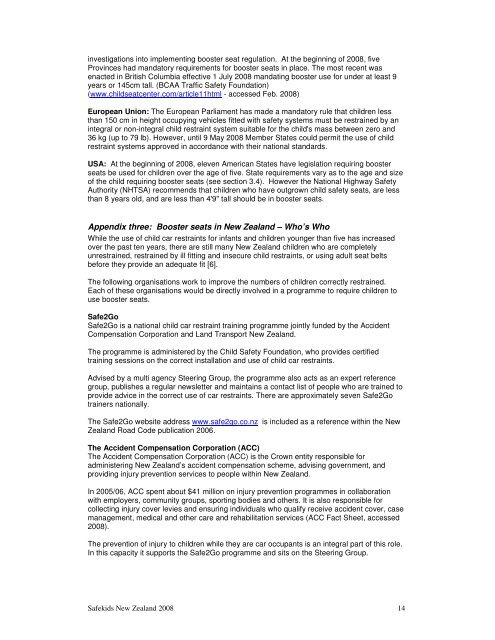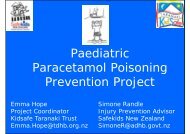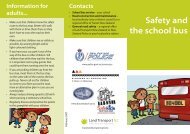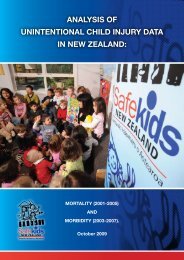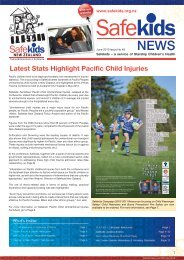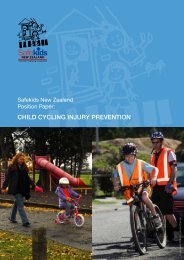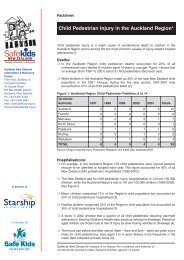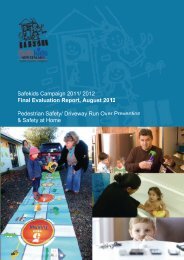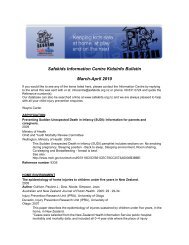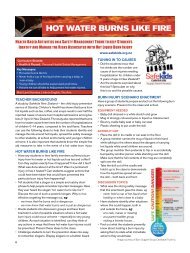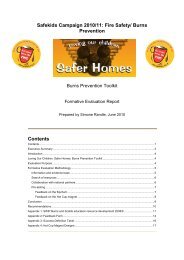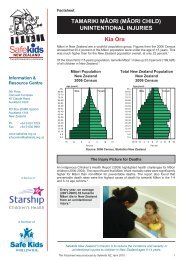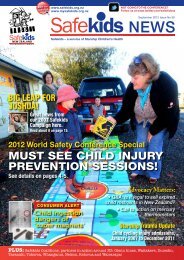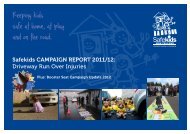Summary It's booster seat time for Kiwi kids - Safekids
Summary It's booster seat time for Kiwi kids - Safekids
Summary It's booster seat time for Kiwi kids - Safekids
You also want an ePaper? Increase the reach of your titles
YUMPU automatically turns print PDFs into web optimized ePapers that Google loves.
investigations into implementing <strong>booster</strong> <strong>seat</strong> regulation. At the beginning of 2008, five<br />
Provinces had mandatory requirements <strong>for</strong> <strong>booster</strong> <strong>seat</strong>s in place. The most recent was<br />
enacted in British Columbia effective 1 July 2008 mandating <strong>booster</strong> use <strong>for</strong> under at least 9<br />
years or 145cm tall. (BCAA Traffic Safety Foundation)<br />
(www.child<strong>seat</strong>center.com/article11html - accessed Feb. 2008)<br />
European Union: The European Parliament has made a mandatory rule that children less<br />
than 150 cm in height occupying vehicles fitted with safety systems must be restrained by an<br />
integral or non-integral child restraint system suitable <strong>for</strong> the child's mass between zero and<br />
36 kg (up to 79 lb). However, until 9 May 2008 Member States could permit the use of child<br />
restraint systems approved in accordance with their national standards.<br />
USA: At the beginning of 2008, eleven American States have legislation requiring <strong>booster</strong><br />
<strong>seat</strong>s be used <strong>for</strong> children over the age of five. State requirements vary as to the age and size<br />
of the child requiring <strong>booster</strong> <strong>seat</strong>s (see section 3.4). However the National Highway Safety<br />
Authority (NHTSA) recommends that children who have outgrown child safety <strong>seat</strong>s, are less<br />
than 8 years old, and are less than 4'9" tall should be in <strong>booster</strong> <strong>seat</strong>s.<br />
Appendix three: Booster <strong>seat</strong>s in New Zealand – Who’s Who<br />
While the use of child car restraints <strong>for</strong> infants and children younger than five has increased<br />
over the past ten years, there are still many New Zealand children who are completely<br />
unrestrained, restrained by ill fitting and insecure child restraints, or using adult <strong>seat</strong> belts<br />
be<strong>for</strong>e they provide an adequate fit [6].<br />
The following organisations work to improve the numbers of children correctly restrained.<br />
Each of these organisations would be directly involved in a programme to require children to<br />
use <strong>booster</strong> <strong>seat</strong>s.<br />
Safe2Go<br />
Safe2Go is a national child car restraint training programme jointly funded by the Accident<br />
Compensation Corporation and Land Transport New Zealand.<br />
The programme is administered by the Child Safety Foundation, who provides certified<br />
training sessions on the correct installation and use of child car restraints.<br />
Advised by a multi agency Steering Group, the programme also acts as an expert reference<br />
group, publishes a regular newsletter and maintains a contact list of people who are trained to<br />
provide advice in the correct use of car restraints. There are approximately seven Safe2Go<br />
trainers nationally.<br />
The Safe2Go website address www.safe2go.co.nz is included as a reference within the New<br />
Zealand Road Code publication 2006.<br />
The Accident Compensation Corporation (ACC)<br />
The Accident Compensation Corporation (ACC) is the Crown entity responsible <strong>for</strong><br />
administering New Zealand’s accident compensation scheme, advising government, and<br />
providing injury prevention services to people within New Zealand.<br />
In 2005/06, ACC spent about $41 million on injury prevention programmes in collaboration<br />
with employers, community groups, sporting bodies and others. It is also responsible <strong>for</strong><br />
collecting injury cover levies and ensuring individuals who qualify receive accident cover, case<br />
management, medical and other care and rehabilitation services (ACC Fact Sheet, accessed<br />
2008).<br />
The prevention of injury to children while they are car occupants is an integral part of this role.<br />
In this capacity it supports the Safe2Go programme and sits on the Steering Group.<br />
Safe<strong>kids</strong> New Zealand 2008 14


